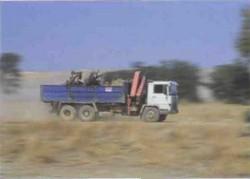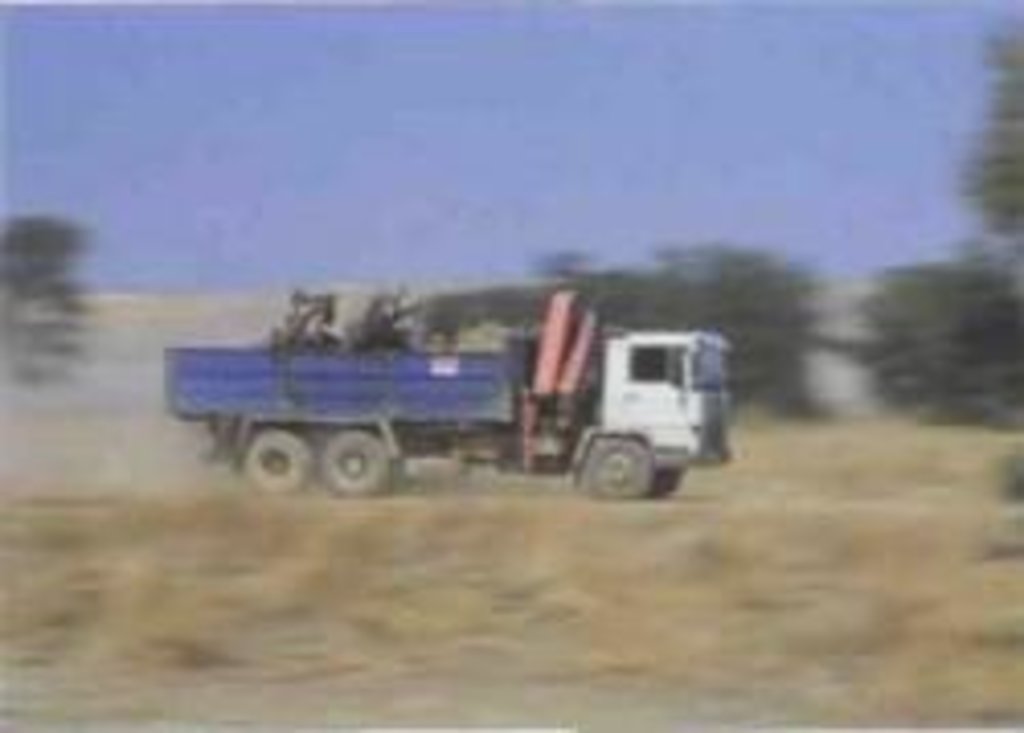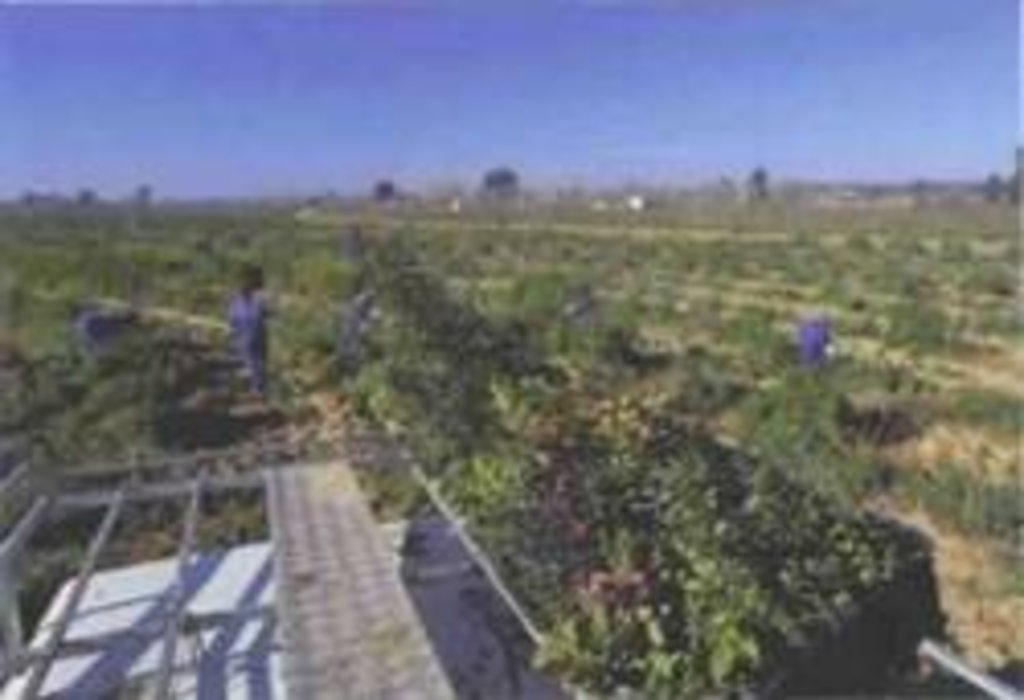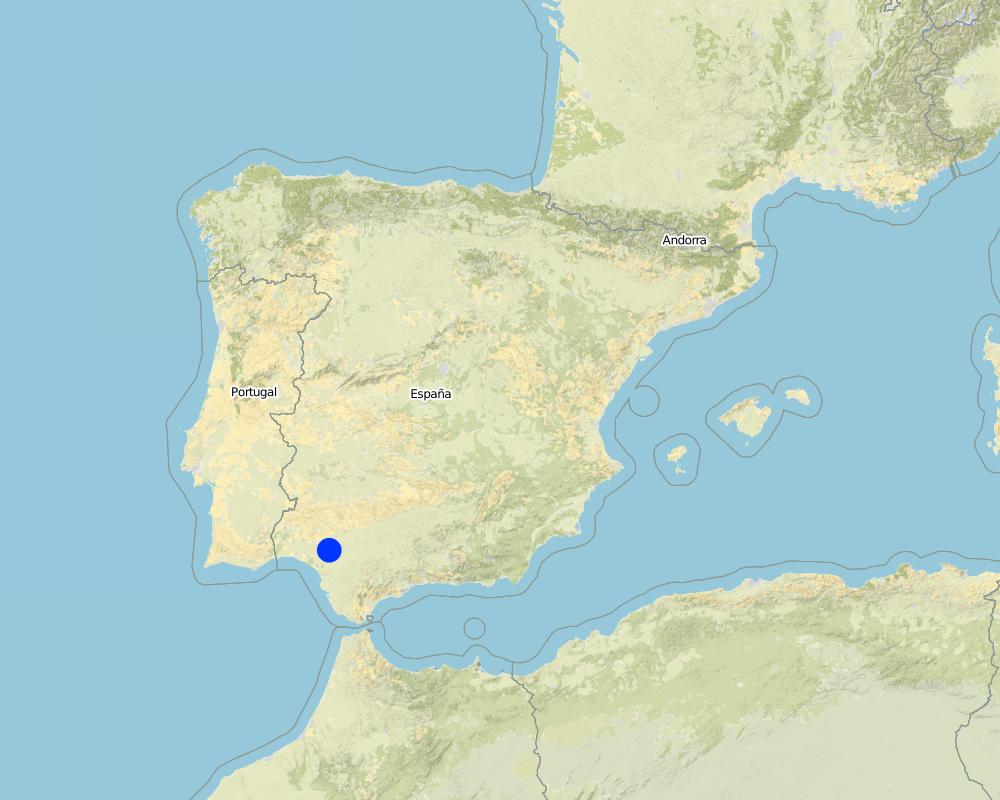Caso de estudio del Guadiamar [Spain]
- Creation:
- Update:
- Compiler: José Miguel Pérez-Álvarez
- Editor: –
- Reviewer: Deborah Niggli
approaches_2528 - Spain
View sections
Expand all Collapse all1. General information
1.2 Contact details of resource persons and institutions involved in the assessment and documentation of the Approach
SLM specialist:
SLM specialist:
SLM specialist:
SLM specialist:
Marañón Arana Teodoro
IRNAS-CSIC
Spain
SLM specialist:
Cabrera Capitán Francisco
IRNAS-CSIC
Spain
Name of project which facilitated the documentation/ evaluation of the Approach (if relevant)
Preventing and Remediating degradation of soils in Europe through Land Care (EU-RECARE )Name of the institution(s) which facilitated the documentation/ evaluation of the Approach (if relevant)
IRNAS-CSIC (IRNAS-CSIC) - Spain1.3 Conditions regarding the use of data documented through WOCAT
When were the data compiled (in the field)?
13/07/2015
The compiler and key resource person(s) accept the conditions regarding the use of data documented through WOCAT:
Yes
1.4 Reference(s) to Questionnaire(s) on SLM Technologies
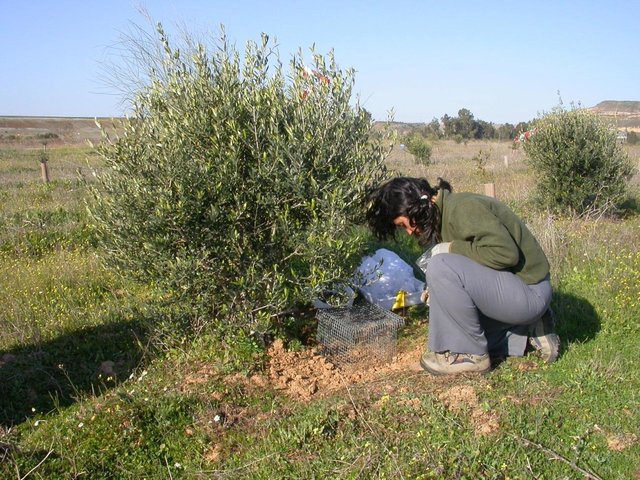
Fitoestabilización de suelos contaminados [Spain]
Introducción de plantas para la inmovilización de los elementos traza contaminantes del suelo
- Compiler: José Miguel Pérez-Álvarez
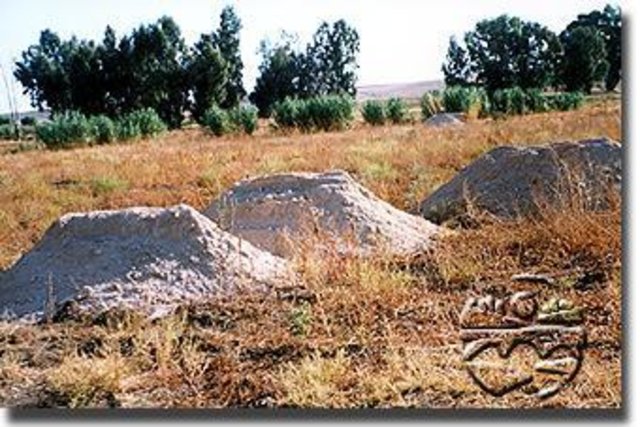
Adición de enmiendas a suelos contaminados [Spain]
Aplicación de enmiendas para la recuperación de suelos contaminados con elementos traza
- Compiler: José Miguel Pérez-Álvarez
2. Description of the SLM Approach
2.1 Short description of the Approach
Medidas de recuperación del suelo y revegetación desarrolladas en 1999-2000 para reducir la movilidad de los elementos traza del suelo.
2.2 Detailed description of the Approach
Detailed description of the Approach:
Recuperar el área afectada por la contaminación minera.
Retirada de lodos, aplicación de enmiendas, gradeo y revegetación. Expropiación de terrenos afectados y protección del área como espacio natural.
(1) Limpieza de emergencia/retirada de lodos
(2) Aplicación de enmiendas
(3) Expropiación de terrenos afectados
(4) Revegetación de la zona
(5) Declaración de paisaje protegido
La administración regional fue la encargada de limpiar la zona, reforestar, expropiar los terrenos. Actualmente es la encargada de mantener y gestionar el área. Los usuarios de la tierra realizan un uso recreativo de la zona y de pastoreo extensivo.
2.3 Photos of the Approach
2.5 Country/ region/ locations where the Approach has been applied
Country:
Spain
Region/ State/ Province:
Sevilla
Further specification of location:
Corredor verde del Guadiamar
Map
×2.6 Dates of initiation and termination of the Approach
Indicate year of initiation:
1999
Year of termination (if Approach is no longer applied):
2000
2.7 Type of Approach
- project/ programme based
2.8 Main aims/ objectives of the Approach
Recuperar el área afectada por la contaminación minera.
Problemas: El principal problema fue la contaminación, y la alarma social generada.
2.9 Conditions enabling or hindering implementation of the Technology/ Technologies applied under the Approach
social/ cultural/ religious norms and values
- hindering
No se podía actual de forma rápida y general, en tierras privadas.
Tratamiento: Se expropiaron las tierras contaminadas.
availability/ access to financial resources and services
- hindering
Las medidas de limpieza, recuperación y reforestación fueron muy costosas.
Tratamiento: La administración mantiene un pleito con la empresa responsable del vertido para que se haga cargo de los costos.
institutional setting
- hindering
Diferencias entre la administración local, regional y central.
Tratamiento: Coordinación entre administraciones.
legal framework (land tenure, land and water use rights)
- enabling
The existing land ownership, land use rights / water rights greatly helped the approach implementation: El que la tierra fuese privada dificultaba la aplicación de enmiendas, por lo que la zona fue expropiada a sus propietarios, creando así el Corredor Verde.
- hindering
Riesgo de intoxicación por alimentos contaminados.
Tratamiento: Prohibición de toda actividad agrícola, ganadera, caza y pesca.
knowledge about SLM, access to technical support
- hindering
Falta de precedentes y protocolos de actuación ante accidentes similares.
Tratamiento: Se crearon nuevos protocolos de actuación. Se crearon grupos de expertos para asesorar.
workload, availability of manpower
- hindering
Zona muy extensa, heterogénea y urgencia en la actuación
Tratamiento: Organización, se dividió el área en tres zonas, asumiendo la responsabilidad distintas entidades. Movilización de personal laboral para participar en las labores de limpieza.
3. Participation and roles of stakeholders involved
3.1 Stakeholders involved in the Approach and their roles
- local land users/ local communities
- community-based organizations
3.2 Involvement of local land users/ local communities in the different phases of the Approach
| Involvement of local land users/ local communities | Specify who was involved and describe activities | |
|---|---|---|
| initiation/ motivation | none | |
| planning | none | |
| implementation | none | |
| monitoring/ evaluation | none | |
| Research | none |
3.4 Decision-making on the selection of SLM Technology/ Technologies
Specify who decided on the selection of the Technology/ Technologies to be implemented:
- SLM specialists alone
Explain:
Grupo de expertos que asesoraron a políticos.
El desastre ecológico de Aznalcollar provocó que un vertido de un volumen aproximado de dos mil millones de litros de lodos y otros cuatro mil millones de agua contaminada, al río Agrio y al Guadiamar, afectando a una franja de 62 Km. aproximadamente de longitud y 500 m. de anchura media, desde la Mina hasta Entremuros, en el límite con el Parque Nacional de Doñana, sobre una superficie de 4.634 has, pertenecientes a nueve municipios de la provincia de Sevilla.
De forma inmediata tras el accidente, se puso en marcha una comisión de coordinación entre la Administración del Estado y la Junta de Andalucía, para abordar las medidas de urgencia que minimizaran los efectos de la catástrofe, de forma que las medidas iniciales sobre contención de la riada tóxica, salvaguardia de la salud de los habitantes de la zona y sobre protección frente a nuevos vertidos procedentes de la balsa siniestrada.
4. Technical support, capacity building, and knowledge management
4.1 Capacity building/ training
Was training provided to land users/ other stakeholders?
Yes
Specify who was trained:
- land users
- field staff/ advisers
- investigación
Form of training:
- demonstration areas
- public meetings
- courses
Subjects covered:
Concienciación y divulgación sobre los efectos de los contaminantes.
4.2 Advisory service
Do land users have access to an advisory service?
Yes
Describe/ comments:
Asistencias técnicas con centros de investigación: Moderadamente adecuado. Es el gobierno local el que ha liderado todo el proceso y por tanto está capacitado para asegurar la continuidad.
4.3 Institution strengthening (organizational development)
Have institutions been established or strengthened through the Approach?
- yes, moderately
Specify the level(s) at which institutions have been strengthened or established:
- local
Specify type of support:
- financial
- capacity building/ training
- equipment
4.4 Monitoring and evaluation
Is monitoring and evaluation part of the Approach?
Yes
4.5 Research
Was research part of the Approach?
Yes
Specify topics:
- sociology
- ecology
- technology
Give further details and indicate who did the research:
Consejo Superior de Investigaciones Científicas, Universidades.
5. Financing and external material support
5.1 Annual budget for the SLM component of the Approach
If precise annual budget is not known, indicate range:
- > 1,000,000
Comments (e.g. main sources of funding/ major donors):
Gobierno nacional (Plan especial del Gobierno central): 20.0%; Gobierno local (distrito, provincia,municipalidad, aldea etc) (Junta de Andalucía): 80.0%
5.2 Financial/ material support provided to land users
Did land users receive financial/ material support for implementing the Technology/ Technologies?
No
5.4 Credit
Was credit provided under the Approach for SLM activities?
No
5.5 Other incentives or instruments
Were other incentives or instruments used to promote implementation of SLM Technologies?
No
6. Impact analysis and concluding statements
6.1 Impacts of the Approach
Did the Approach help land users to implement and maintain SLM Technologies?
- No
- Yes, little
- Yes, moderately
- Yes, greatly
El enfoque ha ayudado a la administración regional a mejorar el manejo sostenible de la zona recuperada.
Did the Approach empower socially and economically disadvantaged groups?
- No
- Yes, little
- Yes, moderately
- Yes, greatly
La mejora es para los usuarios de la tierra en general, independientemente de su nivel económico.
Did the Approach improve issues of land tenure/ user rights that hindered implementation of SLM Technologies?
- No
- Yes, little
- Yes, moderately
- Yes, greatly
La zona fue expropiada.
Did other land users / projects adopt the Approach?
- No
- Yes, little
- Yes, moderately
- Yes, greatly
Did the Approach lead to improved livelihoods / human well-being?
- No
- Yes, little
- Yes, moderately
- Yes, greatly
Se produjo un cambio de uso de la tierra, creándose lo que hoy día se conoce como El corredor verde del Guadiamar. Él corredor verde es de libre acceso y uno lo los nuevos usos de la zona son las actividades de ocio y bienestar.
Did the Approach help to alleviate poverty?
- No
- Yes, little
- Yes, moderately
- Yes, greatly
La implementación de la tecnología originó un gran número de jornales.
6.2 Main motivation of land users to implement SLM
- rules and regulations (fines)/ enforcement
- prestige, social pressure/ social cohesion
- aesthetic improvement
6.3 Sustainability of Approach activities
Can the land users sustain what has been implemented through the Approach (without external support)?
- yes
If yes, describe how:
La zona está convertida en un paisaje protegido, que requiere un mantenimiento mínimo.
6.4 Strengths/ advantages of the Approach
| Strengths/ advantages/ opportunities in the compiler’s or other key resource person’s view |
|---|
| Se ha conseguido una recuperación efectiva de una zona contaminada. (How to sustain/ enhance this strength: Realizar monitorizaciones para comprobar si son necesarias nuevas intervenciones.) |
6.5 Weaknesses/ disadvantages of the Approach and ways of overcoming them
| Weaknesses/ disadvantages/ risks in the compiler’s or other key resource person’s view | How can they be overcome? |
|---|---|
| El método utilizado no elimina al 100% la contaminación, si no que estabiliza los contaminantes. | No es posible superarlo, puesto que sacar los elementos traza del suelo es imposible sin alterar sus propiedades. |
7. References and links
7.1 Methods/ sources of information
- field visits, field surveys
- interviews with land users
7.2 References to available publications
Title, author, year, ISBN:
Xiong, J., Madejon, P., Madejon, E., Cabrera, F. Assisted natural remediation of a trace element-contaminated acid soil: An eight-year field study (2015) Pedosphere, 25 (2), pp. 250-262. DOI: 10.1016/S1002-0160(15)60010-8
Title, author, year, ISBN:
Burgos, P., Madejón, P., Madejón, E., Girón, I., Cabrera, F., Murillo, J.M. Natural remediation of an unremediated soil twelve years after a mine accident: Trace element mobility and plant composition (2013) Journal of Environmental Management, 114, pp. 36-45. DOI: 10.1016/j.jenvman.2012.10.060
Title, author, year, ISBN:
Pérez-De-Mora, A., Madejón, P., Burgos, P., Cabrera, F., Lepp, N.W., Madejón, E. Phytostabilization of semiarid soils residually contaminated with trace elements using by-products: Sustainability and risks (2011) Environmental Pollution, 159 (10), pp. 3018-3027. DOI: 10.1016/j.envpol.2011.04.015
Available from where? Costs?
Internet
Title, author, year, ISBN:
Domínguez, M.T., Madejón, P., Marañón, T., Murillo, J.M. Afforestation of a trace-element polluted area in SW Spain: Woody plant performance and trace element accumulation (2010) European Journal of Forest Research, 129 (1), pp. 47-59.DOI: 10.1007/s10342-008-0253-3
Available from where? Costs?
Internet
Title, author, year, ISBN:
Madejón, P., Pérez-de-Mora, A., Burgos, P., Cabrera, F., Lepp, N.W., Madejón, E. Do amended, polluted soils require re-treatment for sustainable risk reduction? - Evidence from field experiments. (2010) Geoderma, 159 (1-2), pp. 174-181. DOI: 10.1016/j.geoderma.2010.07.009
Available from where? Costs?
Internet
Title, author, year, ISBN:
Madejón, E., Madejón, P., Burgos, P., Pérez de Mora, A., Cabrera, F. Trace elements, pH and organic matter evolution in contaminated soils under assisted natural remediation: A 4-year field study (2009) Journal of Hazardous Materials, 162 (2-3), pp. 931-938. DOI: 10.1016/j.jhazmat.2008.05.119
Available from where? Costs?
Internet
Title, author, year, ISBN:
Domínguez, M.T., Marañón, T., Murillo, J.M., Schulin, R., Robinson, B.H. Trace element accumulation in woody plants of the Guadiamar Valley, SW Spain: A large-scale phytomanagement case study (2008) Environmental Pollution, 152 (1), pp. 50-59. DOI: 10.1016/j.envpol.2007.05.021
Available from where? Costs?
Internet
Title, author, year, ISBN:
Pérez-de-Mora, A., Madrid, F., Cabrera, F., Madejón, E. Amendments and plant cover influence on trace element pools in a contaminated soil (2007) Geoderma, 139 (1-2), pp. 1-10. Cited 35 times. DOI: 10.1016/j.geoderma.2006.12.001
Available from where? Costs?
Internet
Links and modules
Expand all Collapse allLinks

Fitoestabilización de suelos contaminados [Spain]
Introducción de plantas para la inmovilización de los elementos traza contaminantes del suelo
- Compiler: José Miguel Pérez-Álvarez

Adición de enmiendas a suelos contaminados [Spain]
Aplicación de enmiendas para la recuperación de suelos contaminados con elementos traza
- Compiler: José Miguel Pérez-Álvarez
Modules
No modules


